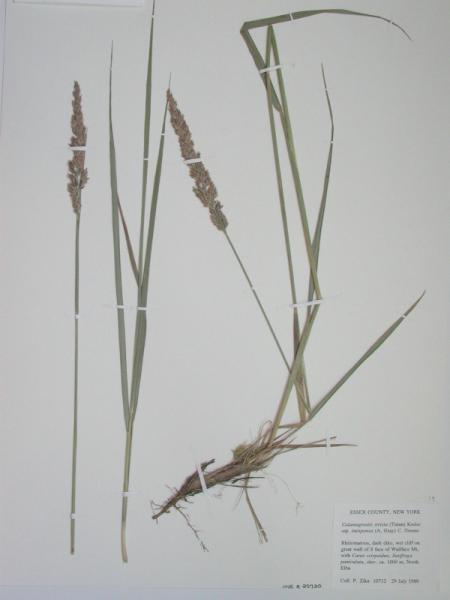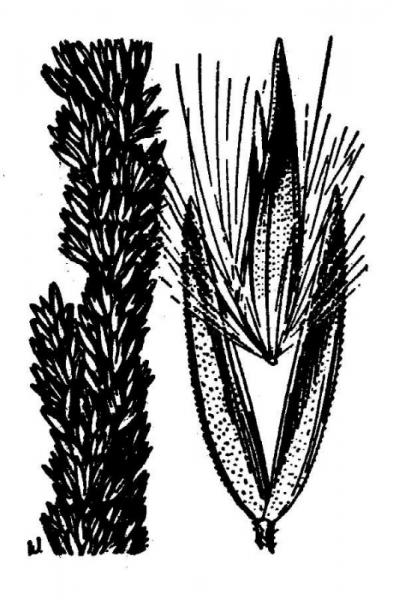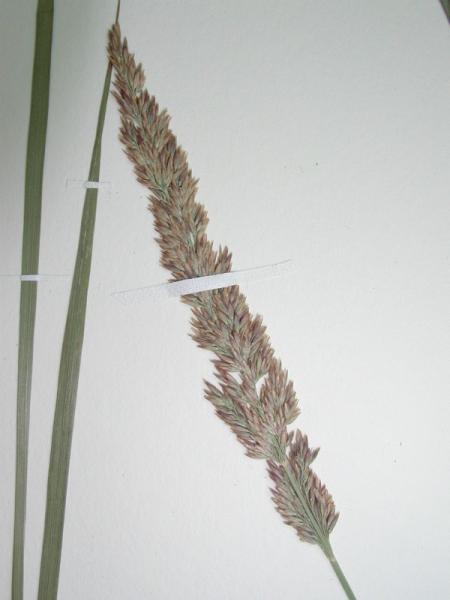Northern Reed Grass
Calamagrostis stricta (Timm) Koel.
- Class
- Monocotyledoneae (Monocots)
- Family
- Poaceae (Grass Family)
- State Protection
- Not Listed
- Federal Protection
- Not Listed
- State Conservation Status Rank
- S2
Imperiled in New York - Very vulnerable to disappearing from New York due to rarity or other factors; typically 6 to 20 populations or locations in New York, very few individuals, very restricted range, few remaining acres (or miles of stream), and/or steep declines.
- Global Conservation Status Rank
- G5
Secure globally - Common in the world; widespread and abundant (but may be rare in some parts of its range).
Summary
Did you know?
Calamagrostis stricta has a circumboreal distribution; the same species is found in the northern regions of Europe and Asia as well as North America. "Stricta" refers to the upright, rather than spreading, form of the infloresence.
State Ranking Justification
Despite the fairly broad range of habitat Calamagrostis stricta occupies, there are only 13 verified occurrences in the state. Of these 13 extant locations, 4 are large and protected. There appears to be plenty of available habitat, so this grass species may have been overlooked. There are also 6 historical occurrences dating from the 1940s.
Short-term Trends
The existing populations of this species appear to be stable.
Long-term Trends
The history of this species in New York is not well known, so long-term trends are unclear.
Conservation and Management
Threats
The alpine summit occurences of this plant are threatened by trampling from hikers. At fens and other wetland sites changes to the hydrologic regime, or to the soil and water chemistry, are potential threats.
Conservation Strategies and Management Practices
Populations on alpine summits should be protected from disturbance by active stewardship and education, and should be monitored. Other populations should be protected from disturbances and hydrologic changes.
Research Needs
The response of this species to ongoing changes in its alpine environment should be studied.
Habitat
Habitat
In New York Calamagrostis stricta has been found in a diversity of habitats. It occurs in calcareous wetlands, including fens and wet meadows, and on sandy or cobbly lake, pond, or river shores. It also has been collected from cliffs, krummholz, and alpine meadows in the high peaks of the Adirondacks (New York Natural Heritage Program 2008). Wet meadows and marshes (Gleason and Cronquist 1991). Wet meadows, marshes, damp woods (Haines 1998).
Associated Ecological Communities
- Alpine sliding fen*
(guide)
A shallow peat bog on 5-35 degree slopes on the brow of alpine or subalpine cliffs.
- Calcareous shoreline outcrop
(guide)
A community that occurs along the shores of lakes and streams on outcrops of calcareous rocks such as limestone and dolomite. The vegetation is sparse; most plants are rooted in rock crevices.
- Cobble shore wet meadow
(guide)
A community that occurs on the cobble shores of lakes and streams where the substrate is moist from seepage or intermittent flooding. These communities are likely to be scoured by floods or winter ice floes, but there is apparently no significant accumulation of pack ice.
- Medium fen*
(guide)
A wetland fed by water from springs and seeps. These waters are slightly acidic (pH values generally range from 4.5 to 6.5) and contain some dissolved minerals. Plant remains in these fens do not decompose rapidly and thus the plants in these fens usually grow on older, undecomposed plant parts of woody material, grasses, and mosses.
- Open alpine community
(guide)
An open community consisting of a mosaic of sedge/dwarf shrub meadows, dwarf heath shrublands, small boggy depressions, and exposed bedrock covered with lichens and mosses. The open alpine community occurs above timberline (about 4,900 ft or 1,620 m) on the higher mountain summits and exposed ledges of the Adirondacks. The flora includes arctic-alpine species that are restricted (in New York) to these areas, as well as boreal species that occur in forests and bogs at lower elevations. The soils are thin and organic, primarily composed of peat derived from peat mosses (Sphagnum spp.) or black muck. The soils are often saturated because they can be recharged by atmospheric moisture.
- Rich graminoid fen
(guide)
A wetland of mostly grasses usually fed by water from highly calcareous springs or seepage. These waters have high concentrations of minerals and high pH values, generally from 6.0 to 7.8. Plant remains do not decompose rapidly and these grasses usually grow on older, undecomposed plant parts.
- Rich shrub fen
(guide)
A wetland with many shrubs that is usually fed by water from springs and seeps. These waters have high concentrations of minerals and high pH values, generally from 6.0 to 7.8. Plant remains in these fens do not decompose rapidly and thus the plants in these fens usually grow on older, undecomposed woody plant parts.
- Riverside ice meadow*
(guide)
A meadow community that occurs on gently sloping cobble shores and rock outcrops along large rivers in areas where winter ice floes are pushed up onto the shore, forming an ice pack that remains until late spring. The ice scours the meadow, cutting back woody plants.
* probable association but not confirmed.
Associated Species
- Betula pumila (bog birch)
- Carex aquatilis (water sedge)
- Carex echinata
- Carex lasiocarpa
- Carex stricta (tussock sedge)
- Chamaedaphne calyculata (leatherleaf)
- Ilex verticillata (common winterberry)
- Myrica sp.
- Rhynchospora alba (white beak sedge)
Range
New York State Distribution
Calamagrostis stricta is widely scattered in New York, though most extant locations are in the Adirondacks and adjacent areas of northeastern New York.
Global Distribution
Calamagrostis stricta has a circumboreal distribution. In North America it is found throughout Canada and most the western US, and ranges east through the Midwest and most of the northeastern states (excluding Massachusetts and Rhode Island) to as far south as New Jersey, Pennsylvania, and West Virginia.
Identification Comments
General Description
Northern Reed Grass is a perennial grass which may grow up to 1 m tall, and spreads by underground stems (rhizomes). The leaf blades are rolled inward, and 2 to 6 mm wide when unrolled. The stems are topped by an open branching array of small flowers (the inflorescence), 5 to 12 cm long and 5 to 15 mm wide. The main axis and primary branches of the infloresence are scabrous (rough) (Aiken et al 2003). As in all grasses, the small, inconspicuous flowers occur in scaly structures called spikelets. In the genus Calamagrostis each spikelet contains only one flower. In Northern Reedgrass one of these scales (the lemma) has a slender tip (an awn) 4 to 4.5 mm long (Harvey 2007).
Best Life Stage for Proper Identification
Northern Reed Grass is best identified from specimens with mature fruit.
Similar Species
There are six other species of Calamagrostis in New York. Calamagrostis stricta may be distinguished from most of the others by its having an awn attached near the middle of the lemma. C. pickeringii (which may occupy similar habitats to C. stricta), C. porteri, and C. perplexa (an extremely rare species restricted to the southeastern part of the state) each have awns attached to the lemma near its base.
C. epigejos and C. canadensis each may have awns inserted near the middle of the lemma as does Calamagrostis stricta. C. epigejos (not native to New York, and largely restricted to weedy sites) has hairs extending from the thickened base of the lemma (the callus) and well exceeding the lemma, while C. stricta has callus hairs which do not exeed the lemma. C. canadensis has a looser and more spreading infloresence than that of C. stricta, especially at the base of the infloresence, and the lemma is smooth (the lemma of C. stricta is scabrous).
Best Time to See
The spikelets of Calamagrostis stricta mature in late July or early August, and the fruits may persist into September.
- Fruiting
The time of year you would expect to find Northern Reed Grass fruiting in New York.
Northern Reed Grass Images
Taxonomy
Northern Reed Grass
Calamagrostis stricta (Timm) Koel.
- Kingdom Plantae
- Phylum Anthophyta
- Class Monocotyledoneae
(Monocots)
- Order Cyperales
- Family Poaceae (Grass Family)
- Order Cyperales
- Class Monocotyledoneae
(Monocots)
- Phylum Anthophyta
Synonyms
- Calamagrostis canadensis var. robusta Vasey
- Calamagrostis inexpansa Gray
- Calamagrostis lacustris (Kearney) Nash
- Calamagrostis neglecta (Ehrh.) Gaertn., Mey., & Scherb. [a <i>nomen illeg.</i>]
- Calamagrostis pickeringii var. lacustris (Kearney) Hitch.
- Calamagrostis stricta ssp. inexpansa (Gray) C.W. Greene
- Calamagrostis stricta ssp. inexpansa var. lacustris (Kearney) C.W. Greene
- Calamagrostis stricta ssp. stricta
- Calamagrostis stricta var. inexpansa Vasey
- Calamagrostis stricta var. stricta
Comments on the Classification
There are two subspecies of Calamagrostis stricta in New York: subspecies stricta and subspecies inexpansa. Both are taxa of concern in the state. Most occurrences of the species in New York are subspecies stricta. Additional study of the variation within this species is needed.
Additional Resources
References
Edinger, Gregory J., D.J. Evans, Shane Gebauer, Timothy G. Howard, David M. Hunt, and Adele M. Olivero (editors). 2002. Ecological Communities of New York State. Second Edition. A revised and expanded edition of Carol Reschke's Ecological Communities of New York State. (Draft for review). New York Natural Heritage Program, New York State Department of Environmental Conservation. Albany, NY. 136 pp.
Fernald, M.L. 1950. Gray's manual of botany. 8th edition. D. Van Nostrand, New York. 1632 pp.
Gleason, Henry A. and A. Cronquist. 1991. Manual of Vascular Plants of Northeastern United States and Adjacent Canada. The New York Botanical Garden, Bronx, New York. 910 pp.
Holmgren, Noel. 1998. The Illustrated Companion to Gleason and Cronquist's Manual. Illustrations of the Vascular Plants of Northeastern United States and Adjacent Canada. The New York Botanical Garden, Bronx, New York.
Mitchell, Richard S. and Gordon C. Tucker. 1997. Revised Checklist of New York State Plants. Contributions to a Flora of New York State. Checklist IV. Bulletin No. 490. New York State Museum. Albany, NY. 400 pp.
New York Natural Heritage Program. 2005. Biotics Database. Albany, NY.
New York Natural Heritage Program. 2024. New York Natural Heritage Program Databases. Albany, NY.
Voss, E.G. 1972. Michigan Flora, Part I. Gymnosperms and Monocots. Cranbrook Institute of Science Bulletin 55 and the University of Michigan Herbarium. Ann Arbor. 488 pp.
Weldy, Troy W. and David Werier. 2005. New York Flora Atlas. [S.M. Landry, K.N. Campbell, and L.D. Mabe (original application development), Florida Center for Community Design and Research. University of South Florida]. New York Flora Association, Albany, NY. Available on the web at (http://newyork.plantatlas.usf.edu/).
Links
About This Guide
Information for this guide was last updated on: May 22, 2008
Please cite this page as:
New York Natural Heritage Program. 2024.
Online Conservation Guide for
Calamagrostis stricta.
Available from: https://guides.nynhp.org/northern-reed-grass/.
Accessed July 26, 2024.


